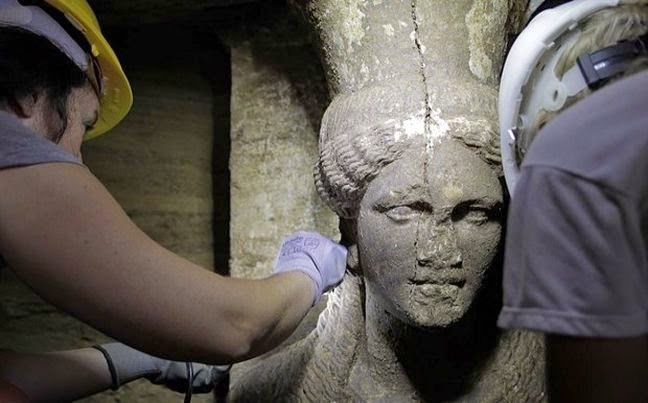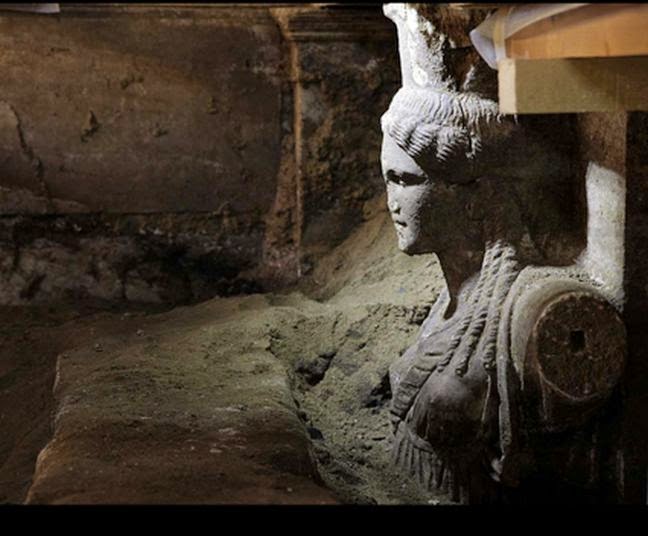Two excellent Caryatid artefacts, made of dewy marble with a pessary, 0,20x0,60m in cross section, were discovered yesterday (Saturday, September 6), the day of the archeological works at the Kastas tomb of Ancient Amphipolis, a fact that -according to experts- advocates view that it is an outstanding monument of special importance.
According to a statement from the Ministry of Culture, "the face of western coconut is almost intact, while the eastern one is missing. Caryatids have rich pebbles, which cover their shoulders, wear earrings, and wear a sleeveless tunic. Her right hand and the other's left were protruding, so that with their movement they could symbolically prevent those who would attempt to enter the tomb and were inserted. In other words, the same technique is followed, as in the heads and wings of Sphinxes. The figures, on which traces of red and blue are preserved, refer to the type of the Daughter. Fragments of sculptures were found among the sandy soils, such as a palm section and smaller fragments of their fingers. The layout of the second entrance with the caryatids is an important finding, which supports the view that it is a prominent monument of special importance ".
The Ministry of Culture's information bulletin on the progress of work on the tomb of Ancient Amphipolis, recently released, states that on Thursday, September 4, a wide-ranging meeting was held at the Kastas construction site under the auspices of the Ministry of Culture and Sports. Lina Mendoni, with the interdisciplinary team, headed by K. Peristeri and the participation of executives of the Directorate of Ancient Monuments of the Ministry of Culture.
The meeting assessed the overall measures taken to protect the monument, after the torrential rain of the previous 24 hours, which were considered absolutely satisfactory. At the same time, the works for the restoration and support of the structural elements inside the monument continued, in order to develop, in a safe way, the excavation works.
"On Friday, September 5, the soil was removed, behind the second diaphragm wall, in order to balance the geostatic impulses of the earth between the two spaces. With the removal of the soil, a marble rectangular slab, 2 m long and 4,5 m wide, was discovered, at a distance of about 4.2 meters from the dome and approximately 1 meters from the floor. and thickness 0.21m, in excellent condition. It rests marginally on a porous stone of the third septal wall and on the upper part of the orthomarbling, which has a wave. At the bottom of the plate there is a written decoration in blue, red and yellow, where there are panels with rosettes in the center. This is part of the roof of this space.
In the same area, created between the second and third septal walls, a significant reduction in the cross-section of the domes was observed, in parts of both the western and the eastern part of the dome. The crown of the dome was supported, by placing wooden beams in contact with a foam substrate and vertical support.
Support was also provided for the second diaphragm wall, which has an entablature and cornice, with a wooden frame and transverse supports made of metal tubular beams. In addition, the operating conditions of the entablature were revealed. It was found that the vertical crack of the epithelium extends to its entire height and is translucent. In the space in front of the entablature, a triangular metal frame was placed, parallel to its southern side. The entablature was supported by four side supports, which rest on the metal frame, "the ministry said in a statement.
"On Saturday, September 6, the removal of the soil in front of the entablature, allowed the serious reinforcement of the pillar of its broken part, with vertical tubular beams, in wooden contact.
With the removal of the sandy soils, in the area in front of the second diaphragm wall, two marble artifacts were discovered under the marble entablature, among the marble pillars, two of excellent art, made of Thassite marble with pillars, with a cross section of 0,20 x 0,60 m. .
The face of western coconut is almost intact, while the eastern one is missing. Caryatids have rich pebbles, which cover their shoulders, wear earrings, and wear a sleeveless tunic. Her right hand and the other's left were protruding, so that with their movement they could symbolically prevent those who would attempt to enter the tomb and were inserted. In other words, the same technique is followed, as in the heads and wings of Sphinxes. The figures, on which traces of red and blue are preserved, refer to the type of the Daughter. Fragments of sculptures were found among the sandy soils, such as a palm section and smaller fragments of their fingers. The layout of the second entrance with the caryatids is an important finding, which suggests that it is a prominent monument of great importance.
In front of the caryatids, and from the height of their waist and below, a sealing wall of poroliths is revealed along the entire width of 4,5 m. This is the second sealing wall, which follows the same technique as on the facade of the burial monument. It is another feature of the manufacturers' effort to prevent entry to the monument. "



